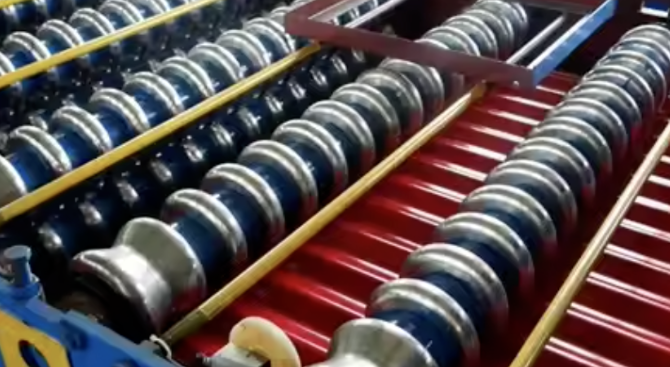
Posted on Monday, October 21, 2024
A corrugated roof sheet roll forming machine is used to manufacture corrugated metal sheets, typically for roofing and cladding purposes. Here’s a simplified breakdown of how these machines work:
The process starts with a metal coil (usually steel or aluminum) being placed onto an uncoiler. The uncoiler feeds the flat sheet of metal into the roll forming machine. This coil is often pre-treated or coated to prevent corrosion.
The flat metal sheet is fed into the roll forming machine’s entry section, where it aligns and is ready to be shaped. This part ensures the metal is fed in the correct position and speed.
The core of the machine consists of multiple pairs of roller dies. These roller dies are precisely shaped to form the desired corrugated pattern. As the flat metal sheet passes through each pair of rollers, it gets progressively bent into the corrugated shape. The roller stations are arranged in a sequence, each one applying a bit more deformation until the final profile is achieved.
Once the metal sheet has been fully formed into the desired corrugated profile, it moves to the cutting section. Here, a cutting mechanism (typically a hydraulic shear) cuts the sheet to the required length. The cutting process can be synchronized with the machine’s production speed, and modern machines often have automated systems that ensure precision cutting without stopping the process.
The formed and cut sheets are then stacked and collected for further handling, packaging, or shipping. Some machines have an automatic stacking mechanism, which arranges the sheets neatly for easy handling.
This process allows for the efficient production of roofing sheets that are durable, lightweight, and weather-resistant, making them ideal for construction purposes.

Most Popular Roll Forming Machines in the United Kingdom
Posted on Thursday, December 11, 2025
This blog breaks down the five most in-demand roll forming machines in the UK

Can I Finance a Roll Forming Machine?
Posted on Thursday, December 11, 2025
Financing a roll forming machine is easier than most buyers think. Here’s how leases, loans, and payment plans make production affordable.

Roll Forming Machines for Sale in the UK: What Buyers Need to Know Before Purchasing
Posted on Thursday, December 11, 2025
This complete guide explains everything UK buyers must know before purchasing, including machine types, voltage requirements, CE/UKCA compliance

Roll Forming Machines for Sale in the USA: What Buyers Need to Know Before Purchasing
Posted on Wednesday, December 10, 2025
This guide explains everything U.S. buyers need to know before purchasing a roll forming machine, including machine types, pricing, voltage
Copyright 2026 © Machine Matcher.